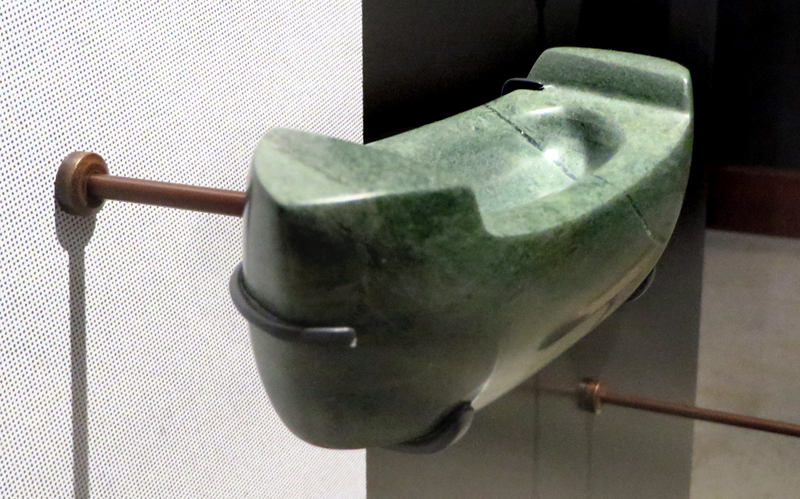Actinolite canoe carving by Ted Garcia, 2012.
On display in the Natural History Museum of Los Angeles County's permanent "Becoming Los Angeles" exhibit, which opened July 14, 2013.
SCV Connection:
 Ted A. Garcia is chief of the Southern Chumash (having succeeded Charlie Cooke in December 2008) and spiritual advisor to the Hart of the West Powwow in Newhall.
His Tataviam, Chumash, Tongva and Vanyume ancestors lived in the Santa Clarita, San Fernando and Antelope valleys, as well as parts of Ventura County.
Ted's father, Ted C. Garcia, and grandmother, Chief Mary Cooke Garcia, lived in Newhall and are direct descendants of individuals who
lived at Chaguayabit village (now Castaic Junction) prior to European contact in 1769.
Ted A. Garcia is chief of the Southern Chumash (having succeeded Charlie Cooke in December 2008) and spiritual advisor to the Hart of the West Powwow in Newhall.
His Tataviam, Chumash, Tongva and Vanyume ancestors lived in the Santa Clarita, San Fernando and Antelope valleys, as well as parts of Ventura County.
Ted's father, Ted C. Garcia, and grandmother, Chief Mary Cooke Garcia, lived in Newhall and are direct descendants of individuals who
lived at Chaguayabit village (now Castaic Junction) prior to European contact in 1769.
Ted's gr-gr-gr-grandfather Santiago Garcia was born to American Indian and Californio parents about 1833 when the Mission period ended.
Santiago settled in the Little Rock Creek area, just above modern-day Acton. (Acton lies in Santiago Canyon, which is named for him.)
One of Santiago's sons, Isidoro Garcia — Ted's gr-gr-grandfather — subsequently homesteaded in upper San Francisquito Canyon.
Their forebears carved utilitarian as well as ceremonial and decorative objects from native steatite (soapstone).
Ted has studied the artifacts to understand the ancient culture's subjects and style. Keeping the traditions alive, he executes small, finely crafted
sculptures from locally sourced stone, often using steatite that he gathers in the Santa Clarita Valley.
Museum signage reads:
Native Peoples of the Los Angeles Area
(Editor's note: The term "Gabrieleño-Tongva" refers to the particular Tongva individuals who, during the mission period, were removed
to the Mission San Gabriel — the nearest mission to downtown Los Angeles, which is the focus of the museum exhibit.
It should be recognized that other inland tribes of Los Angeles County, such as the Tataviam of the Santa Clarita Valley and the Kitanemuk
of the Antelope Valley, were also present during the period indicated and were removed to the Mission San Fernando — as were some of the Tongva.
Also, many Chumash were removed to the Mission San Buenaventura in modern-day Ventura.)
The Gabrieleño-Tongva were the Native Americans who occupied the Los Angeles area and the four southern Channel Islands at the time Juan Rodríguez Cabrillo arrived.
On October 7, 1542, Cabrillo was exploring the California coast for Spain and dropped anchor off Santa Catalina in the Channel Islands chain. When Cabrillo's landing party approached the shore in a small boat, a group of the island's inhabitants in a large canoe came out to welcome them. This was the first encounter between the Spanish and the Gabrieleño-Tongva people.
The Gabrieleño-Tongva, together with their Chumash neighbors to the north, occupied the Channel Islands, mainland coastal areas and territories further inland in Southern California. Canoe routes carried people, food, raw materials and manufactured goods between the islands and the mainland, as well as from island to island.
About NHMLA's "Becoming Los Angeles" Exhibit:
The 14,000-square-foot permanent exhibition is the largest in the Museum. It tells stories in six major sections: Los Angeles and the region at the time of Spanish contact; the Spanish Mission Era; the Mexican Rancho Era; the early American Period; the emergence of a new American city in the late 19th and early 20th centuries; the Great Depression and World War II, to the present.
Some of the stories are well known, such as how the acquisition of water through the Los Angeles Aqueduct in 1913 allowed Los Angeles to grow. But there are other natural and human influences might surprise you: how cattle, the Gold Rush, floods, a plague of grasshoppers, railroads, and outlandish booster campaigns all played a part in transforming the region into an agricultural and industrial empire; the pivotal role Los Angeles played in World War II; and the dynamic diversity of the earliest settlers.
Come meet L.A.'s Native Americans, colonists and settlers; rancheros, citrus growers and oil barons; captains of industry, boosters and radicals; filmmakers, innovators and more.






